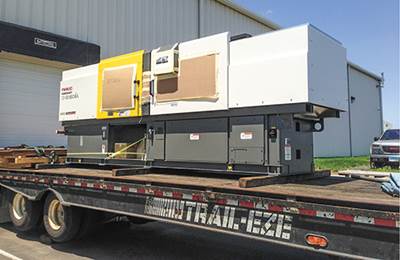Reshoring Remains Strong in 2015
About 200,000 manufacturing jobs have been brought to the U.S. from offshore in the last six years, according to Reshoring Initiative calculations. That gain is the result of both new reshoring and Foreign Direct Investment (FDI) in our manufacturing sector. However, there has been some negative news about reshoring recently that Harry Moser founder and president of the Reshoring Initiative wants to address.

About 200,000 manufacturing jobs have been brought to the US from offshore in the last six years, according to the Reshoring Initiative’s calculations. That job gain is the result of both new reshoring—the return of manufacturing work that was previously produced offshore—plus Foreign Direct Investment (FDI) in our manufacturing sector. It also represents about 22 percent of the total increase in U.S. manufacturing jobs since the recent low of 11.46 million in February 2010. About 12.2 million Americans are now employed in the manufacturing sector. In fact, Reshoring Initiative research shows that more manufacturing work is now coming here than leaving. On a related note, click here for six benefits of reshoring.
However, there is one conflicting report in the headlines from A.T. Kearney that has a negative perspective on reshoring. Moser rejects portions of the report, commenting that, “Some A.T. Kearney statements are completely misleading. A.T. Kearney’s Reshoring Index does not actually measure reshoring. It uses the trend in imports to imply a trend in reshoring. The Reshoring Initiative measures reshoring directly. Since the U.S. has one of the world’s fastest growing economies now, it tends to import more. ”
The Index also appears to ignore the fact that imports’ prices, especially from China, have been rising faster than U.S. prices, according to Moser. "The Index is based on the ratio of the value of imports to the value of U.S. production. Thus a 5 percent relative price increase from 2010 to 2015 would eliminate a third of the calculated change in the ratio," he notes.
Moser goes on to explain that Foreign Direct Investment (FDI) and reshoring are essentially the same phenomenon, just parent company headquarters in different countries. "In both cases the company decides it is more profitable to serve the U.S. market from a U.S.-based factory instead of from a foreign factory," he says, "FDI is strong, in fact in 2015 it is stronger than reshoring."
According to Moser, Kearney claims that the number of reshoring cases/year is off 70 percent from 2013 to 2015 projected. However, his database shows for 2015 projected vs. 2013 that reshoring plus FDI is up 30 percent and reshoring alone reports a smaller 40 percent reduction, but still at about twice the 2011 level.
Kearney also suggests that the jobs leaving China are preferentially going to Mexico, more than the U.S. "Certainly some jobs are. However, a recent survey by Alix Partners showed the U.S. favored over Mexico by 55 to 31 percent, " says Moser. "And, he refutes the claim that the 'reshoring trend seems to be over,' by referencing repeated surveys by Boston Consulting Group, Plastics News/Nexant, Alix Partners and Medical Design Technology thaht show the trend is increasing or at least that commitment to reshore is increasing.
Moser continues, "From a longer-term perspective, reshoring cannot 'be over.' The world will not allow a $0.5 trillion U.S. trade deficit to continue indefinitely. If we do not fix the problem in the next 5 to 10 years, the USD will fall dramatically, making reshoring and FDI easy, but with a smaller U.S. market to serve."
Moser emphasizes, “It is clear that about 25 percent of what is now offshored would be economically reshored today if companies used TCO (Total Cost of Ownership) instead of wage arbitrage or PPV (Purchase Price Variance) to make sourcing and siting decisions. A.T. Kearney would better serve its clients and country if it helped educate companies rather than discourage them.”
Related Content
MMT Chats: 5 in 5 with Best Tool and Engineering
MoldMaking Technology Editorial Director Christina Fuges reveals 5 best practices for improving efficiencies within shops...in 5 minutes. Our guest is Joe Cherluck, President of Best Tool and Engineering in Clinton Township, Michigan.
Read MoreQuestions and Considerations Before Sending Your Mold Out for Service
Communication is essential for proper polishing, hot runner manifold cleaning, mold repair, laser engraving and laser welding services.
Read MoreDynamic Tool Corporation – Creating the Team to Move Moldmaking Into the Future
For 40+ years, Dynamic Tool Corp. has offered precision tooling, emphasizing education, mentoring and innovation. The company is committed to excellence, integrity, safety and customer service, as well as inspiring growth and quality in manufacturing.
Read MoreWhat is Scientific Maintenance? Part 2
Part two of this three-part series explains specific data that toolrooms must collect, analyze and use to truly advance to a scientific maintenance culture where you can measure real data and drive decisions.
Read MoreRead Next
‘Reshoring’ Is Not a Myth
For this molder, 35% to 40% of current sales is new business generated in the past two to three years—and some of that is due to reshoring.
Read MoreLearn How Recruiting and Reshoring Can Fill the Skills Gap
Harry Moser of the Reshoring Initiative will kick off MoldMaking Technology's 2015 Educational Webinar Series on March 10th with a breakdown of evidence that shows manufacturing is returning to the U.S. and that the skilled manufacturing “professions” are a better choice for most of our youth. He'll also present tools for making the required changes in perception within your community.
Read MoreAre You a Moldmaker Considering 3D Printing? Consider the 3D Printing Workshop at NPE2024
Presentations will cover 3D printing for mold tooling, material innovation, product development, bridge production and full-scale, high-volume additive manufacturing.
Read More



















